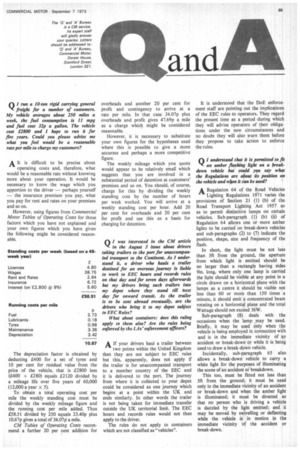Q I run a 10-ton rigid carrying general freight for a
Page 91

If you've noticed an error in this article please click here to report it so we can fix it.
number of customers. My vehicle averages about 250 miles a week, the fuel consumption is 11 mpg and fuel cost 32p a gallon. The vehicle cost 12800 and I hope to run it for five years. Could you please advise me what you feel would be a reasonable rate per mile to charge my customers?
A It is difficult to be precise about operating costs and, therefore, what would be a reasonable rate without knowing more about your operation. It would be necessary to know the wage which you apportion to the driver — perhaps yourself — the insurance premium you pay, what you pay for rent and rates on your premises and so on.
However, using figures from Commercial Motor Tables of Operating Costs for those factors which you have not explained and your own figures which you have given the following might be considered reasonable.
The depreciation factor is obtained by deducting £400 for a set of tyres and 10 per cent for residual value from the price of the vehicle, that is £2800 less
(£400 L280) equals £2120 divided by a mileage life over five years of 60,000 (12,000 a year X 5).
To obtain a total operating cost per mile the weekly standing cost must be divided by the weekly mileage figure and the running cost per mile added. Thus £58.51 divided by 250 equals 23.40p plus 10.67p gives a total of 34.07p a mile.
CM Tables of Operating Costs recommend a further 20 per cent addition for
overheads and another 20 per cent for profit and contingency to arrive at a rate per mile. In that case 34.07p plus overheads and profit gives 47.69p a mile as a charge which might be considered reason able.
However, it is necessary to substitute your own figures for the hypotheses used where this is possible to give a more accurate and perhaps a more competitive figure.
The weekly mileage which you quote would appear to be relatively small which suggests that you are involved in a substantial period of detention at customers' premises and so on. You should, of course. charge for this by dividing the weekly standing cost by the number of hours per week worked. You will arrive at a weekly standing cost per hour. Add 20 per cent for overheads and 20 per cent for profit and use this as a basis for charging for detention.








































































































































